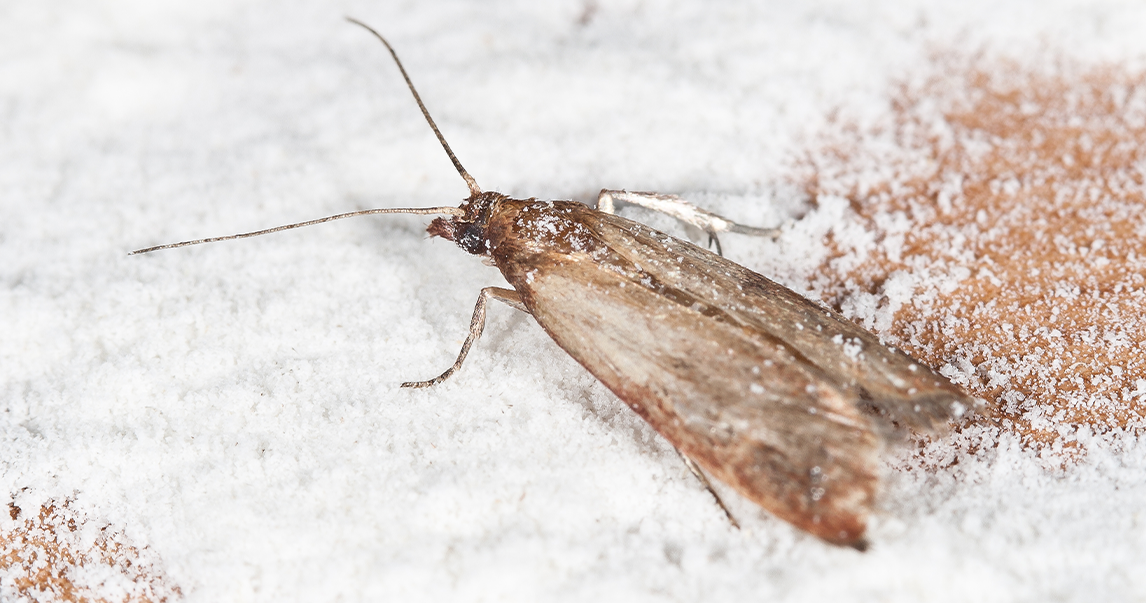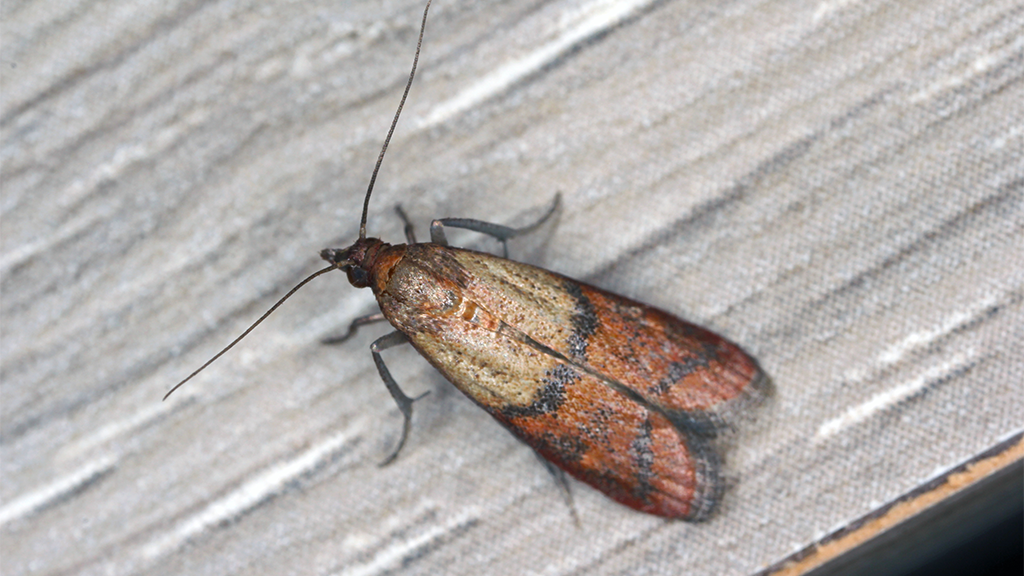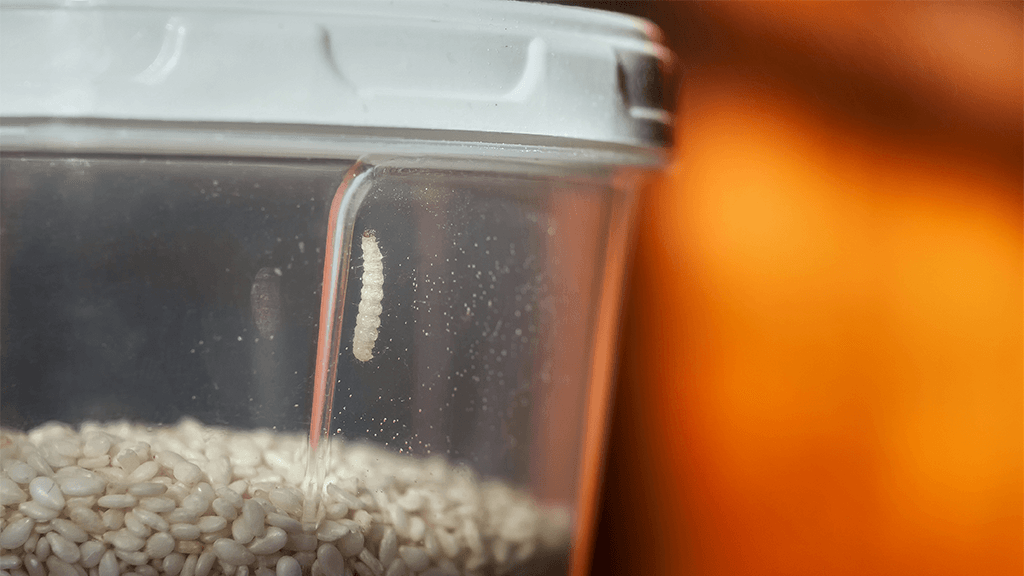How to Prevent and Get Rid of Pantry Moths

It’s one thing to come across a pest on a rarely dusted basement windowsill and entirely another to spot one—or even several—hiding out in a box of your family’s favorite cereal. Pests are certainly unwanted and unwelcome in all areas of our home, but it’s exceptionally horrid when they’re invading our food.
If you suspect you have these food-infesting pests or want to do all that you can to prevent them from showing up in the first place, here’s all you need to know on how to spot pantry moths, how to get rid of them, and how to deter them from settling in your cupboards.
WHAT ARE PANTRY MOTHS?
Pantry moths are any of several species of moth that infest food items by laying their eggs in or around grains, processed foods, and dried goods. They primarily eat grains such as wheat, oats, seeds, cornmeal, and other grain derivatives, but they can also infest packages of dried fruit, nuts, spices, roots, herbs, crackers, cereals, chocolate, pet foods, and birdseed. Very few foods are off the menu when it comes to these insects.
Though a few fluttering moths around are a sure sign of an infestation somewhere nearby, it’s actually the eggs and larvae that do the most damage. In addition to hosting live eggs and larvae, infested food might also contain webbings, shed larval skins, eggshells, and fecal pellets. Because they’re small in size, pantry moths can go unnoticed for a very long time, so intervention at the first sign of an infestation is crucial.
IDENTIFYING PANTRY MOTHS
It is important to recognize each stage in the pantry moth life cycle, as an unusual clump of flour or a couple of extra specks in your oatmeal may be easy to overlook.
EGGS – Measuring less than half a millimeter in size, these tiny, whitish or grey eggs are most often deposited in clusters of as many as 400 at a time. Eggs are typically laid directly on the surface of a larval food source, but movements of the infested container can toss some of the flour or grains on top of the sticky eggs, slightly burying them.
LARVAE – After hatching, moth larvae will grow to be about a half an inch. They’re typically off-white with a tan or brown head, but they can also take on a pinkish, greyish, or even green hue. Moth larvae spin silk webs around themselves as they burrow into your food and eat, so any web-like material found in your food can indicate that these caterpillar-like creatures are burrowing somewhere inside. Larvae can also chew through cardboard and plastic, so small holes in either material can mean the contents inside might be hosting an infestation.
PUPAE – This transitional phase between larvae and adult moths is marked by a pupal case spun away from the food source—sometimes an impressive distance away. Cocoon-like cases house larvae for about a week or up to a month, and catching pupal cases before the transformation cycle is complete can prevent adult moths from emerging, mating, and laying more eggs in or around your pantry. Pupal cases can be located on non-food items and are often tucked away in a secluded safe spot like fabric aprons, wrappers, under labels, and near paper cups and plates.
ADULT MOTHS – Matured moths are about a half an inch long with a wingspan slighter longer than their body length. Their wings are tan or brown in color with a distinct copper luster on the outer two-thirds. Like most moths, they’re attracted to light. Rather than flying into sunlit areas in a clear path, they flutter from place to place, much of the time to an entirely different room of the house since they no longer need constant access to food.
HOW TO GET RID OF PANTRY MOTHS
Pantry moths in all stages can be found even in the most spotless and well-organized pantries, and much of the time they seem to have come out of nowhere. They could have hitchhiked inside on a box of corn flour, laid their eggs early on in the food-packaging process, or even fluttered into a bulk bin at the grocery store. Regardless of how they got there, pantry moths can be eliminated and your kitchen reclaimed.
THROW IT OUT
Check items for infestation and toss them immediately if they show any signs of pantry moth eggs, larvae, or pupae. Check neighboring items, too, and be sure to dispose of them in a tightly sealed bag outside and away from your home.
UPGRADE YOUR FOOD STORAGE
Because larvae can chew through plastic, paper, and cardboard, items kept in their original packaging are left vulnerable to the spread of an infestation. Choose thick, secure, airtight containers for your food storage. Before repackaging items, do a thorough inspection to make sure you’re not locking any pantry moths or their offspring inside the new containers. If you’re not sure whether a newly purchased item is infested or not, place it in the freezer for at least 4 days to kill any potential eggs.
DON’T OVERBUY
Older, less-utilized foods are more likely to host infestations than boxes that are pulled to and from your pantry on a regular basis. A club-sized bag of cornstarch may seem like a good buy at the time, but if it won’t get used within a few months at most, consider buying only what you need to get through the next few weeks. Rotate purchases frequently, using up your older food before digging into more recent buys.
GET IT CLEAN
Pantry moth larvae can be sustained on small amounts of spilled flours and a few grains of rice. As soon as you suspect an infestation, do a thorough cleaning of your pantry and the surrounding cupboards, taking a broom, vacuum, and a few hardy cleaning solutions to the shelves, walls, and floors.
USE PHEROMONE TRAPS
One of the burdens of a pantry pest presence is the sensitive nature of the infested area—namely your food. Fortunately, squashing out an infestation can usually be accomplished by removing infested items and cleaning well using warm, soapy water. If you’d like to add another layer of control, you can use pheromone traps. These are designed to catch male pantry moths and prevent them from mating with females. Be sure to follow all label instructions when using these.
Discovering a pantry moth invasion can not only make you feel queasy, but also hurt your wallet as you watch box after box of infested food get tossed in the trash. As soon as you spot the signs of an infestation, act immediately to intervene using the steps above. And if a pantry moth infestation proves to be more stubborn, consider contacting one of our pest control professionals. No pest problem is too large or small for our team and we are ready to step in to keep pests out of your pantry.




